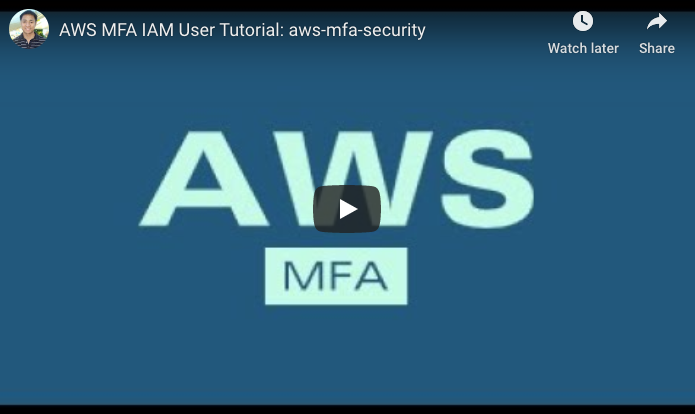Surprisingly, the aws cli does not yet support MFA for normal IAM users. See: boto/botocore/pull/1399 The aws-mfa-secure tool decorates the AWS CLI or API to handle MFA authentication. The MFA prompt only activates if mfa_serial is configured.
An advantage of the aws-mfa-secure is that it caches the temporary credentials ~/.aws/aws-mfa-secure-sessions and reuses them until they expire. The expiration is 8 hours by default. This means that when you open a new terminal tab, you won’t have to re-enter the MFA code.
gem install aws-mfa-secure
Prerequisite: The AWS CLI is required. You can install the AWS CLI via pip.
pip install awscli --upgrade --user
Summary:
- Configure
~/.aws/credentialswithmfa_serial - Set up bash alias
- Use aws cli like you normally would
Set up mfa_serial in credentials file for the profile section that requires it. Example:
~/.aws/credentials:
[mfa]
aws_access_key_id = BKCAXZ6ODJLQ1EXAMPLE
aws_secret_access_key = ABCDl4hXikfOHTvNqFAnb2Ea62bUuu/eUEXAMPLE
mfa_serial = arn:aws:iam::112233445566:mfa/MFAUser
Note: AWS already supports mfa_serial for assumed roles: AWS Configuration and Credential File Settings. The aws-mfa-secure tool does not decorate for assumed roles and lets the AWS CLI or SDK handle it. The aws-mfa-secure tool adds support for standard IAM users, which is not currently supported. See: boto/botocore/pull/1399
alias aws="aws-mfa-secure session"
The alias allows us to intercept the normal aws cli command and decorate it. The aws-mfa-secure session only activates if mfa_serial is configured in your ~/.aws/credentials file. Otherwise, it will pass the command through to the normal aws cli. You may want to add the alias to your ~/.bash_profile do you don't have to alias it every time you open a new terminal.
Autocompletion still works with the alias.
Call aws command like you usually would:
aws s3 ls
$ export AWS_PROFILE=mfa
$ aws s3 ls
Please provide your MFA code: 751888
2019-09-21 15:53:34 my-example-test-bucket
$ aws s3 ls
2019-09-21 15:53:34 my-example-test-bucket
$
Expiration: You get prompted for the MFA token once, and the MFA secure session lasts for 12 hours. You can override the default expiration time with AWS_MFA_TTL. For example, AWS_MFA_TTL=3600 means the session expires in 1 hour instead.
You can also call aws-mfa-secure session directly.
aws-mfa-secure session --version
aws-mfa-secure session s3 ls
The arguments of aws-mfa-secure session are delegated to the aws command. So:
aws-mfa-secure session s3 ls
Is the same as:
aws s3 ls
Except aws-mfa-secure session will use the temporary session environment AWS_* variables values.
You can also generate an exports script. The exports technique is useful for tools that do not yet support MFA. Using AWS_* env variables for credentials should allow those tools to work. Though, it may depend on the tool as they sometimes hardcode a credentials configuration. Example:
$ aws-mfa-secure exports
Please provide your MFA code: 147280
export AWS_ACCESS_KEY_ID=ASIAXZ6ODJLBCEXAMPLE
export AWS_SECRET_ACCESS_KEY=HgYHvNxacSsFSwls1FO9RoF5+tvYCFIABEXAMPLE
export AWS_SESSION_TOKEN=IQoJb3JpZ2luX2VjEJ3//////////wEaCXVzLWVhc3QtMSJGMEQCIGnuGzUr8aszNWMFlFXQvFVhIA6aGdx3DskqY1JaIZWVAiANfE3xA79vIMVTqLnds4F2LpDy/qUeNRr7e9g9VQoS9SqyAQi2//////////8BEAEaDDUzNjc2NjI3MDE3NyIMgDgauwgJ4FIOMRV+KoYBRKR/MnKFB9/Q0Isc6D8gpG404xGJWqStNfGS0sHNsB5vVP/ccaAj4MG54p0Pl+V0LuIMXy345ua/bxxQFDWqhG0ORsXFEOo3iD1IQ+YA/yougAUl/0hbyvK3Jnf3NEHDejdL95iFCluJhoR0zFlDv7GwwBSXLUxS9K96/vgA0MmgK9a7kaAwoYiZ7gU63wHVDNYa1myqIP16Mi6KZ2zm9inMofixNN1ea3JMyRW+chWW8kdjjW4R3MFecpwoIayE7g3QLanmjE3jzrlxjIJWnl8tiipV+jassiSdlxLL2j1IIFH2pNEqrn4hkHG5t7OG+qZCTl8AnQ4W5wusmBoSIavr5w0dOdyx2mdsBMFtO82ZXvHSryY1gbIM9JyUd7dJ9h/mkfGL2p0n0R/lya8s9j8P8/8if+2uQcF+/BGDxojJ67kYXgstgfLjM5j8pZgyYj6YUFyTpyiOkllbPk/AjyxJY1svxW25wbNO+c13
$
You can eval it to set the environment variables in one go. Note, the MFA code prompt is written to standard error so it won't affect the eval.
$ eval `aws-mfa-secure exports`
If you're using the aws-mfa-secure exports command, the aws-mfa-secure unsets command is useful to unset the AWS_* env variables quickly. For more info: aws-mfa-secure unsets -h.
You can also use aws-mfa-secure to add MFA support to Ruby libraries. Do so by requiring the aws_mfa_secure/ext/aws.
require "aws_mfa_secure/ext/aws" # add MFA supportThis patches the aws-sdk-ruby library and adds MFA support.
You can also set the MFA info with env variables. They take the highest precedence and override what's in ~/.aws/credentials. Example:
AWS_MFA_TOKEN=112233 AWS_MFA_SERIAL=arn:aws:iam::112233445566:mfa/MFAUser aws s3 ls
Docs: How It Works
This tool only supports Linux. For Windows, you'll have to set the AWS_* env variables manually. Refer to these resources:
- Switching to an IAM Role (Tools for Windows PowerShell)
- How do I use an MFA token to authenticate access to my AWS resources through the AWS CLI?
You may also be interested in tongueroo/aws-rotate. It's an easy way to rotate all your AWS keys in your ~/.aws/credentials.
- Fork it
- Create your feature branch (
git checkout -b my-new-feature) - Commit your changes (
git commit -am "Add some feature") - Push to the branch (
git push origin my-new-feature) - Create new Pull Request


